CHCCSM005 - Case Management: Development, Facilitation, and Review
VerifiedAdded on 2023/06/17
|26
|8569
|354
Homework Assignment
AI Summary
This assignment focuses on the development, facilitation, and review of all aspects of case management, addressing competency code CHCCSM005. It includes formative assessment activities covering the phases of case management processes, from screening and evaluation to risk differentiation, planning, and implementation. The assignment also explores the statutory requirements, such as documentation and client rights, that case managers must consider. The student provides detailed answers, reflecting an understanding of the theoretical underpinnings of case management and the importance of ethical considerations in service provision. Desklib provides access to this and other solved assignments for students' reference.
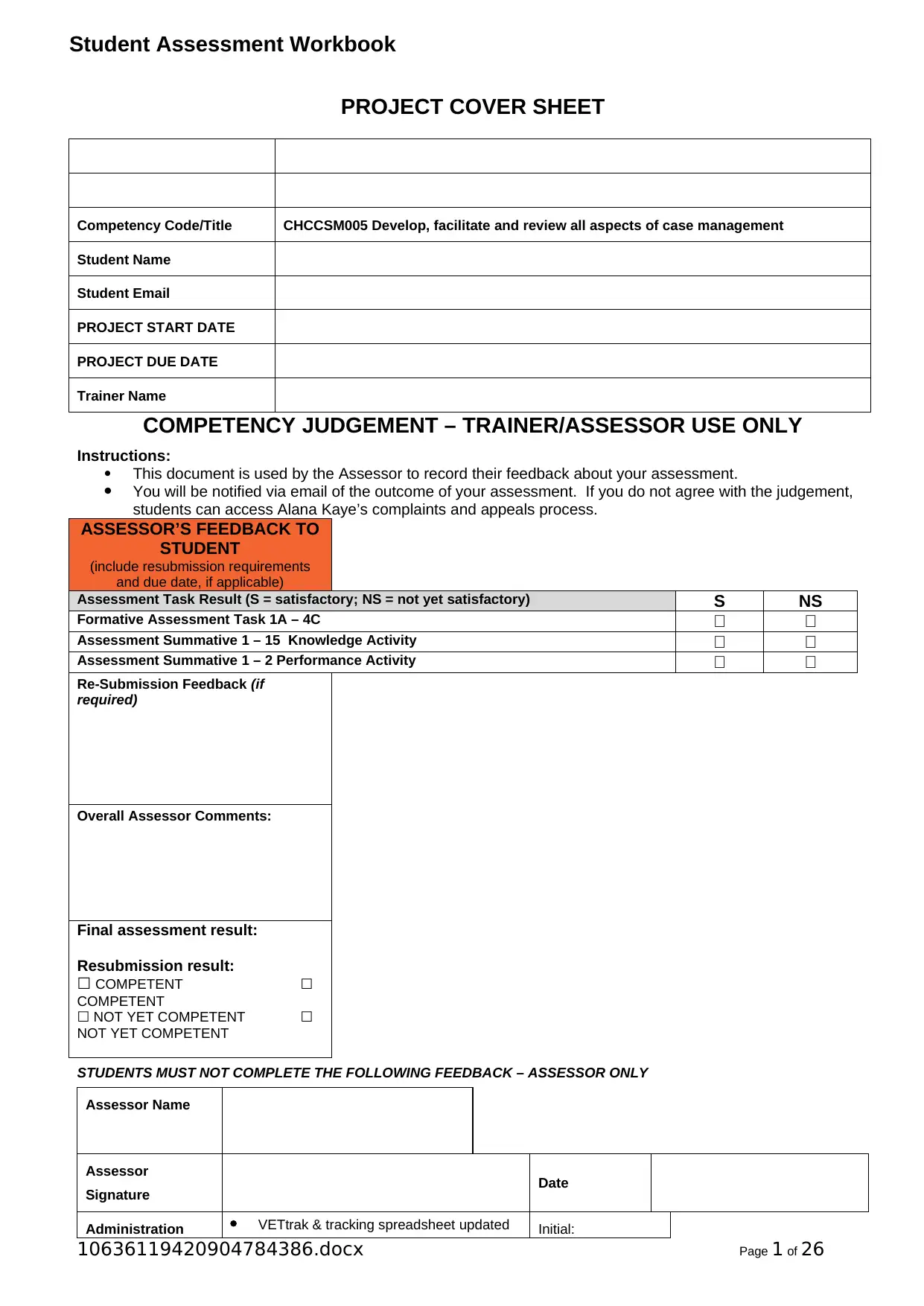
Student Assessment Workbook
PROJECT COVER SHEET
Competency Code/Title CHCCSM005 Develop, facilitate and review all aspects of case management
Student Name
Student Email
PROJECT START DATE
PROJECT DUE DATE
Trainer Name
COMPETENCY JUDGEMENT – TRAINER/ASSESSOR USE ONLY
Instructions:
This document is used by the Assessor to record their feedback about your assessment.
You will be notified via email of the outcome of your assessment. If you do not agree with the judgement,
students can access Alana Kaye’s complaints and appeals process.
ASSESSOR’S FEEDBACK TO
STUDENT
(include resubmission requirements
and due date, if applicable)
Assessment Task Result (S = satisfactory; NS = not yet satisfactory) S NS
Formative Assessment Task 1A – 4C
Assessment Summative 1 – 15 Knowledge Activity
Assessment Summative 1 – 2 Performance Activity
Re-Submission Feedback (if
required)
Overall Assessor Comments:
Final assessment result:
Resubmission result:
☐ COMPETENT ☐
COMPETENT
☐ NOT YET COMPETENT ☐
NOT YET COMPETENT
STUDENTS MUST NOT COMPLETE THE FOLLOWING FEEDBACK – ASSESSOR ONLY
Assessor Name
Assessor
Signature Date
Administration VETtrak & tracking spreadsheet updated Initial:
10636119420904784386.docx Page 1 of 26
PROJECT COVER SHEET
Competency Code/Title CHCCSM005 Develop, facilitate and review all aspects of case management
Student Name
Student Email
PROJECT START DATE
PROJECT DUE DATE
Trainer Name
COMPETENCY JUDGEMENT – TRAINER/ASSESSOR USE ONLY
Instructions:
This document is used by the Assessor to record their feedback about your assessment.
You will be notified via email of the outcome of your assessment. If you do not agree with the judgement,
students can access Alana Kaye’s complaints and appeals process.
ASSESSOR’S FEEDBACK TO
STUDENT
(include resubmission requirements
and due date, if applicable)
Assessment Task Result (S = satisfactory; NS = not yet satisfactory) S NS
Formative Assessment Task 1A – 4C
Assessment Summative 1 – 15 Knowledge Activity
Assessment Summative 1 – 2 Performance Activity
Re-Submission Feedback (if
required)
Overall Assessor Comments:
Final assessment result:
Resubmission result:
☐ COMPETENT ☐
COMPETENT
☐ NOT YET COMPETENT ☐
NOT YET COMPETENT
STUDENTS MUST NOT COMPLETE THE FOLLOWING FEEDBACK – ASSESSOR ONLY
Assessor Name
Assessor
Signature Date
Administration VETtrak & tracking spreadsheet updated Initial:
10636119420904784386.docx Page 1 of 26
Paraphrase This Document
Need a fresh take? Get an instant paraphrase of this document with our AI Paraphraser
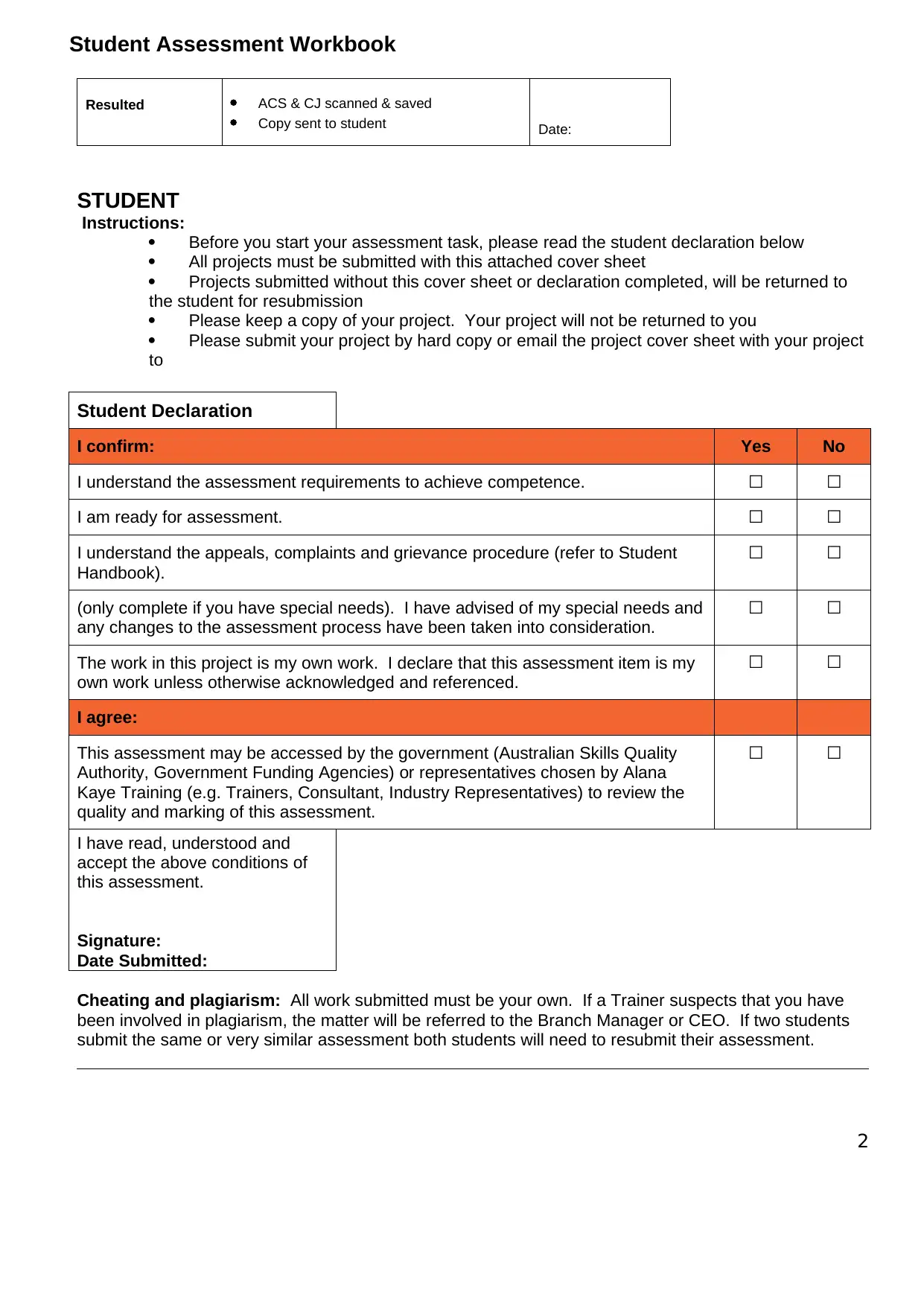
Student Assessment Workbook
Resulted ACS & CJ scanned & saved
Copy sent to student Date:
STUDENT
Instructions:
Before you start your assessment task, please read the student declaration below
All projects must be submitted with this attached cover sheet
Projects submitted without this cover sheet or declaration completed, will be returned to
the student for resubmission
Please keep a copy of your project. Your project will not be returned to you
Please submit your project by hard copy or email the project cover sheet with your project
to
Student Declaration
I confirm: Yes No
I understand the assessment requirements to achieve competence. ☐ ☐
I am ready for assessment. ☐ ☐
I understand the appeals, complaints and grievance procedure (refer to Student
Handbook).
☐ ☐
(only complete if you have special needs). I have advised of my special needs and
any changes to the assessment process have been taken into consideration.
☐ ☐
The work in this project is my own work. I declare that this assessment item is my
own work unless otherwise acknowledged and referenced.
☐ ☐
I agree:
This assessment may be accessed by the government (Australian Skills Quality
Authority, Government Funding Agencies) or representatives chosen by Alana
Kaye Training (e.g. Trainers, Consultant, Industry Representatives) to review the
quality and marking of this assessment.
☐ ☐
I have read, understood and
accept the above conditions of
this assessment.
Signature:
Date Submitted:
Cheating and plagiarism: All work submitted must be your own. If a Trainer suspects that you have
been involved in plagiarism, the matter will be referred to the Branch Manager or CEO. If two students
submit the same or very similar assessment both students will need to resubmit their assessment.
2
Resulted ACS & CJ scanned & saved
Copy sent to student Date:
STUDENT
Instructions:
Before you start your assessment task, please read the student declaration below
All projects must be submitted with this attached cover sheet
Projects submitted without this cover sheet or declaration completed, will be returned to
the student for resubmission
Please keep a copy of your project. Your project will not be returned to you
Please submit your project by hard copy or email the project cover sheet with your project
to
Student Declaration
I confirm: Yes No
I understand the assessment requirements to achieve competence. ☐ ☐
I am ready for assessment. ☐ ☐
I understand the appeals, complaints and grievance procedure (refer to Student
Handbook).
☐ ☐
(only complete if you have special needs). I have advised of my special needs and
any changes to the assessment process have been taken into consideration.
☐ ☐
The work in this project is my own work. I declare that this assessment item is my
own work unless otherwise acknowledged and referenced.
☐ ☐
I agree:
This assessment may be accessed by the government (Australian Skills Quality
Authority, Government Funding Agencies) or representatives chosen by Alana
Kaye Training (e.g. Trainers, Consultant, Industry Representatives) to review the
quality and marking of this assessment.
☐ ☐
I have read, understood and
accept the above conditions of
this assessment.
Signature:
Date Submitted:
Cheating and plagiarism: All work submitted must be your own. If a Trainer suspects that you have
been involved in plagiarism, the matter will be referred to the Branch Manager or CEO. If two students
submit the same or very similar assessment both students will need to resubmit their assessment.
2

Student Assessment Workbook
This page has been left blank intentionally
10636119420904784386.docx Page 3 of 26
This page has been left blank intentionally
10636119420904784386.docx Page 3 of 26
⊘ This is a preview!⊘
Do you want full access?
Subscribe today to unlock all pages.

Trusted by 1+ million students worldwide
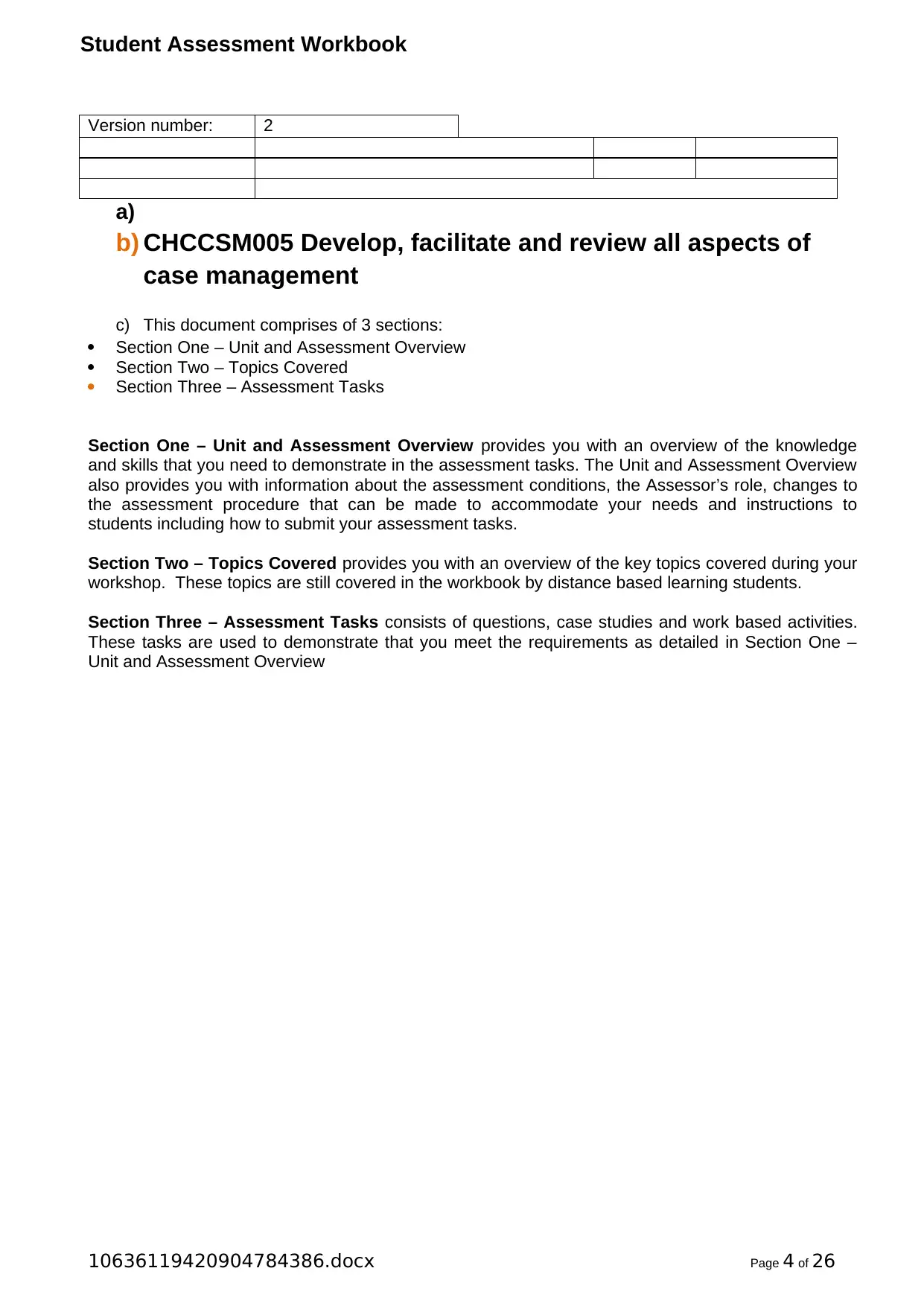
Student Assessment Workbook
Version number: 2
a)
b) CHCCSM005 Develop, facilitate and review all aspects of
case management
c) This document comprises of 3 sections:
Section One – Unit and Assessment Overview
Section Two – Topics Covered
Section Three – Assessment Tasks
Section One – Unit and Assessment Overview provides you with an overview of the knowledge
and skills that you need to demonstrate in the assessment tasks. The Unit and Assessment Overview
also provides you with information about the assessment conditions, the Assessor’s role, changes to
the assessment procedure that can be made to accommodate your needs and instructions to
students including how to submit your assessment tasks.
Section Two – Topics Covered provides you with an overview of the key topics covered during your
workshop. These topics are still covered in the workbook by distance based learning students.
Section Three – Assessment Tasks consists of questions, case studies and work based activities.
These tasks are used to demonstrate that you meet the requirements as detailed in Section One –
Unit and Assessment Overview
10636119420904784386.docx Page 4 of 26
Version number: 2
a)
b) CHCCSM005 Develop, facilitate and review all aspects of
case management
c) This document comprises of 3 sections:
Section One – Unit and Assessment Overview
Section Two – Topics Covered
Section Three – Assessment Tasks
Section One – Unit and Assessment Overview provides you with an overview of the knowledge
and skills that you need to demonstrate in the assessment tasks. The Unit and Assessment Overview
also provides you with information about the assessment conditions, the Assessor’s role, changes to
the assessment procedure that can be made to accommodate your needs and instructions to
students including how to submit your assessment tasks.
Section Two – Topics Covered provides you with an overview of the key topics covered during your
workshop. These topics are still covered in the workbook by distance based learning students.
Section Three – Assessment Tasks consists of questions, case studies and work based activities.
These tasks are used to demonstrate that you meet the requirements as detailed in Section One –
Unit and Assessment Overview
10636119420904784386.docx Page 4 of 26
Paraphrase This Document
Need a fresh take? Get an instant paraphrase of this document with our AI Paraphraser
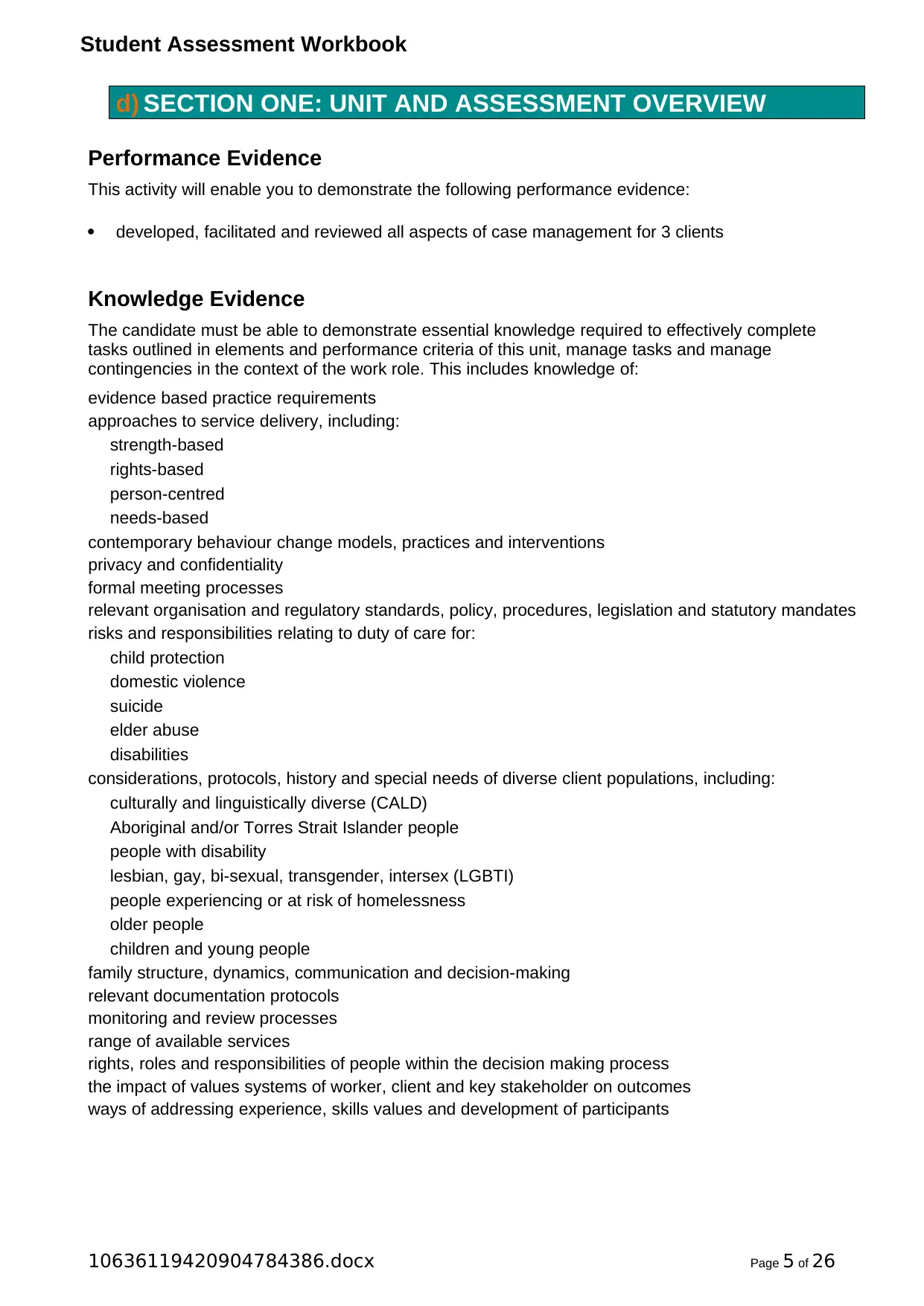
Student Assessment Workbook
d) SECTION ONE: UNIT AND ASSESSMENT OVERVIEW
Performance Evidence
This activity will enable you to demonstrate the following performance evidence:
developed, facilitated and reviewed all aspects of case management for 3 clients
Knowledge Evidence
The candidate must be able to demonstrate essential knowledge required to effectively complete
tasks outlined in elements and performance criteria of this unit, manage tasks and manage
contingencies in the context of the work role. This includes knowledge of:
evidence based practice requirements
approaches to service delivery, including:
strength-based
rights-based
person-centred
needs-based
contemporary behaviour change models, practices and interventions
privacy and confidentiality
formal meeting processes
relevant organisation and regulatory standards, policy, procedures, legislation and statutory mandates
risks and responsibilities relating to duty of care for:
child protection
domestic violence
suicide
elder abuse
disabilities
considerations, protocols, history and special needs of diverse client populations, including:
culturally and linguistically diverse (CALD)
Aboriginal and/or Torres Strait Islander people
people with disability
lesbian, gay, bi-sexual, transgender, intersex (LGBTI)
people experiencing or at risk of homelessness
older people
children and young people
family structure, dynamics, communication and decision-making
relevant documentation protocols
monitoring and review processes
range of available services
rights, roles and responsibilities of people within the decision making process
the impact of values systems of worker, client and key stakeholder on outcomes
ways of addressing experience, skills values and development of participants
10636119420904784386.docx Page 5 of 26
d) SECTION ONE: UNIT AND ASSESSMENT OVERVIEW
Performance Evidence
This activity will enable you to demonstrate the following performance evidence:
developed, facilitated and reviewed all aspects of case management for 3 clients
Knowledge Evidence
The candidate must be able to demonstrate essential knowledge required to effectively complete
tasks outlined in elements and performance criteria of this unit, manage tasks and manage
contingencies in the context of the work role. This includes knowledge of:
evidence based practice requirements
approaches to service delivery, including:
strength-based
rights-based
person-centred
needs-based
contemporary behaviour change models, practices and interventions
privacy and confidentiality
formal meeting processes
relevant organisation and regulatory standards, policy, procedures, legislation and statutory mandates
risks and responsibilities relating to duty of care for:
child protection
domestic violence
suicide
elder abuse
disabilities
considerations, protocols, history and special needs of diverse client populations, including:
culturally and linguistically diverse (CALD)
Aboriginal and/or Torres Strait Islander people
people with disability
lesbian, gay, bi-sexual, transgender, intersex (LGBTI)
people experiencing or at risk of homelessness
older people
children and young people
family structure, dynamics, communication and decision-making
relevant documentation protocols
monitoring and review processes
range of available services
rights, roles and responsibilities of people within the decision making process
the impact of values systems of worker, client and key stakeholder on outcomes
ways of addressing experience, skills values and development of participants
10636119420904784386.docx Page 5 of 26
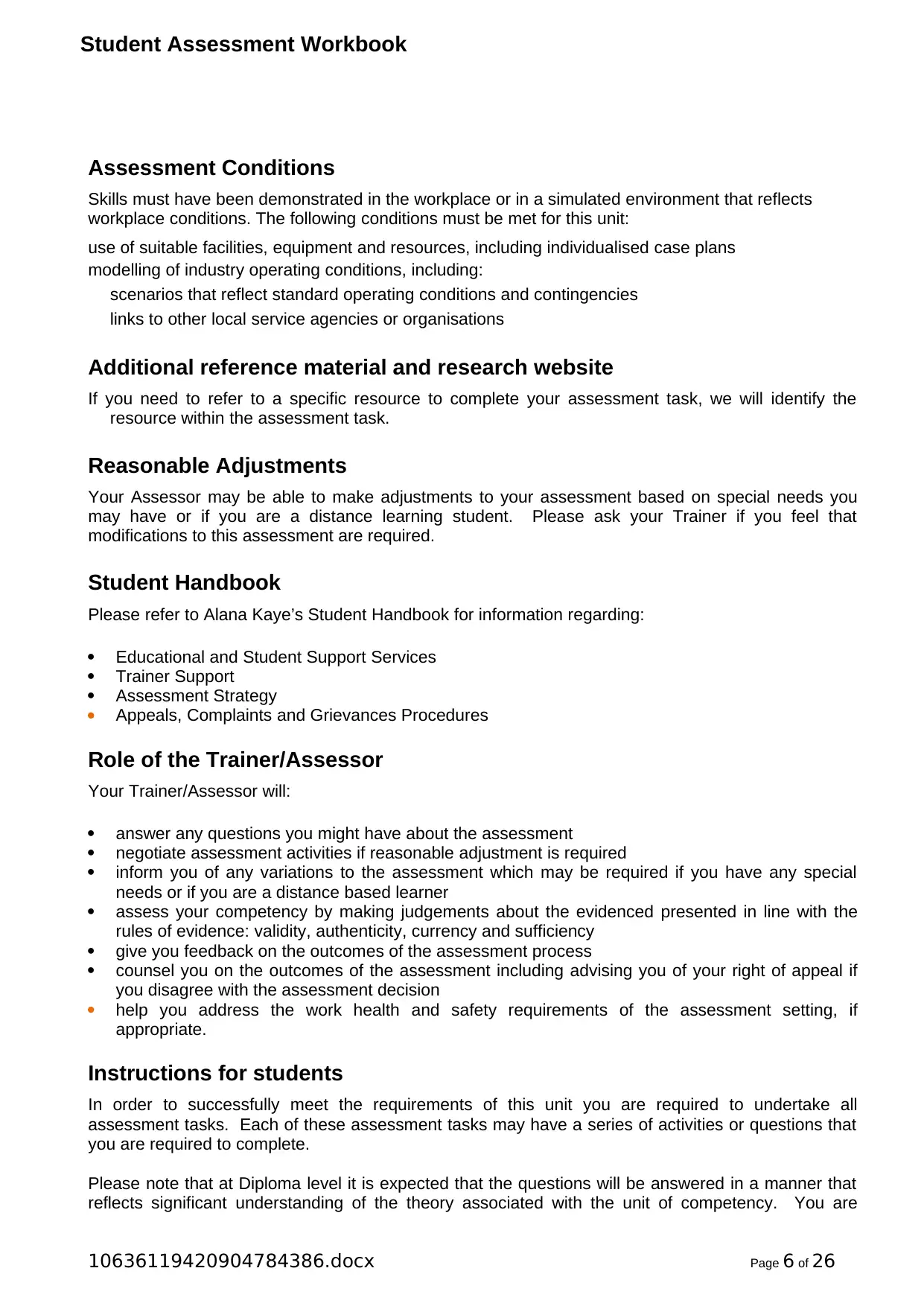
Student Assessment Workbook
Assessment Conditions
Skills must have been demonstrated in the workplace or in a simulated environment that reflects
workplace conditions. The following conditions must be met for this unit:
use of suitable facilities, equipment and resources, including individualised case plans
modelling of industry operating conditions, including:
scenarios that reflect standard operating conditions and contingencies
links to other local service agencies or organisations
Additional reference material and research website
If you need to refer to a specific resource to complete your assessment task, we will identify the
resource within the assessment task.
Reasonable Adjustments
Your Assessor may be able to make adjustments to your assessment based on special needs you
may have or if you are a distance learning student. Please ask your Trainer if you feel that
modifications to this assessment are required.
Student Handbook
Please refer to Alana Kaye’s Student Handbook for information regarding:
Educational and Student Support Services
Trainer Support
Assessment Strategy
Appeals, Complaints and Grievances Procedures
Role of the Trainer/Assessor
Your Trainer/Assessor will:
answer any questions you might have about the assessment
negotiate assessment activities if reasonable adjustment is required
inform you of any variations to the assessment which may be required if you have any special
needs or if you are a distance based learner
assess your competency by making judgements about the evidenced presented in line with the
rules of evidence: validity, authenticity, currency and sufficiency
give you feedback on the outcomes of the assessment process
counsel you on the outcomes of the assessment including advising you of your right of appeal if
you disagree with the assessment decision
help you address the work health and safety requirements of the assessment setting, if
appropriate.
Instructions for students
In order to successfully meet the requirements of this unit you are required to undertake all
assessment tasks. Each of these assessment tasks may have a series of activities or questions that
you are required to complete.
Please note that at Diploma level it is expected that the questions will be answered in a manner that
reflects significant understanding of the theory associated with the unit of competency. You are
10636119420904784386.docx Page 6 of 26
Assessment Conditions
Skills must have been demonstrated in the workplace or in a simulated environment that reflects
workplace conditions. The following conditions must be met for this unit:
use of suitable facilities, equipment and resources, including individualised case plans
modelling of industry operating conditions, including:
scenarios that reflect standard operating conditions and contingencies
links to other local service agencies or organisations
Additional reference material and research website
If you need to refer to a specific resource to complete your assessment task, we will identify the
resource within the assessment task.
Reasonable Adjustments
Your Assessor may be able to make adjustments to your assessment based on special needs you
may have or if you are a distance learning student. Please ask your Trainer if you feel that
modifications to this assessment are required.
Student Handbook
Please refer to Alana Kaye’s Student Handbook for information regarding:
Educational and Student Support Services
Trainer Support
Assessment Strategy
Appeals, Complaints and Grievances Procedures
Role of the Trainer/Assessor
Your Trainer/Assessor will:
answer any questions you might have about the assessment
negotiate assessment activities if reasonable adjustment is required
inform you of any variations to the assessment which may be required if you have any special
needs or if you are a distance based learner
assess your competency by making judgements about the evidenced presented in line with the
rules of evidence: validity, authenticity, currency and sufficiency
give you feedback on the outcomes of the assessment process
counsel you on the outcomes of the assessment including advising you of your right of appeal if
you disagree with the assessment decision
help you address the work health and safety requirements of the assessment setting, if
appropriate.
Instructions for students
In order to successfully meet the requirements of this unit you are required to undertake all
assessment tasks. Each of these assessment tasks may have a series of activities or questions that
you are required to complete.
Please note that at Diploma level it is expected that the questions will be answered in a manner that
reflects significant understanding of the theory associated with the unit of competency. You are
10636119420904784386.docx Page 6 of 26
⊘ This is a preview!⊘
Do you want full access?
Subscribe today to unlock all pages.

Trusted by 1+ million students worldwide
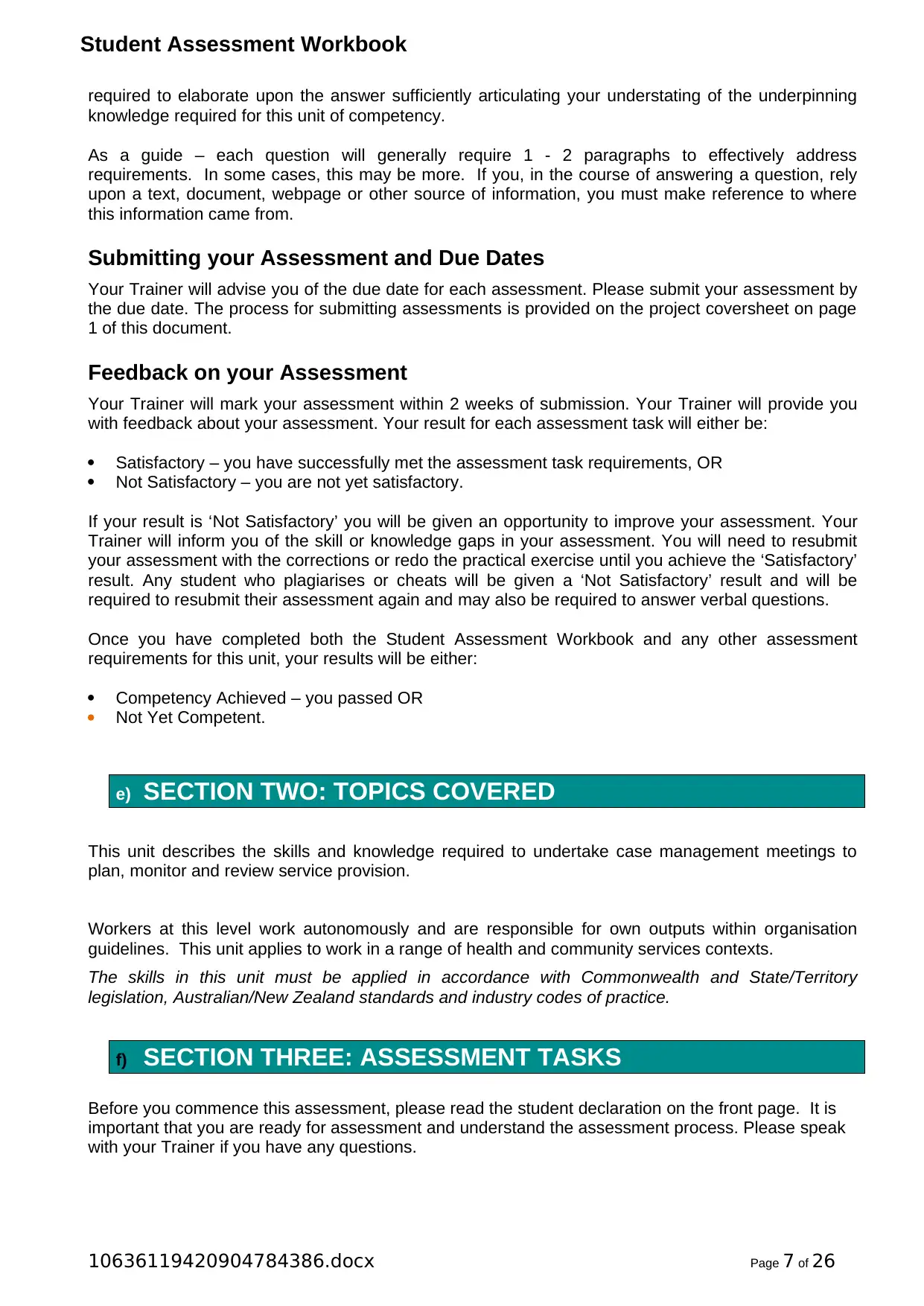
Student Assessment Workbook
required to elaborate upon the answer sufficiently articulating your understating of the underpinning
knowledge required for this unit of competency.
As a guide – each question will generally require 1 - 2 paragraphs to effectively address
requirements. In some cases, this may be more. If you, in the course of answering a question, rely
upon a text, document, webpage or other source of information, you must make reference to where
this information came from.
Submitting your Assessment and Due Dates
Your Trainer will advise you of the due date for each assessment. Please submit your assessment by
the due date. The process for submitting assessments is provided on the project coversheet on page
1 of this document.
Feedback on your Assessment
Your Trainer will mark your assessment within 2 weeks of submission. Your Trainer will provide you
with feedback about your assessment. Your result for each assessment task will either be:
Satisfactory – you have successfully met the assessment task requirements, OR
Not Satisfactory – you are not yet satisfactory.
If your result is ‘Not Satisfactory’ you will be given an opportunity to improve your assessment. Your
Trainer will inform you of the skill or knowledge gaps in your assessment. You will need to resubmit
your assessment with the corrections or redo the practical exercise until you achieve the ‘Satisfactory’
result. Any student who plagiarises or cheats will be given a ‘Not Satisfactory’ result and will be
required to resubmit their assessment again and may also be required to answer verbal questions.
Once you have completed both the Student Assessment Workbook and any other assessment
requirements for this unit, your results will be either:
Competency Achieved – you passed OR
Not Yet Competent.
e) SECTION TWO: TOPICS COVERED
This unit describes the skills and knowledge required to undertake case management meetings to
plan, monitor and review service provision.
Workers at this level work autonomously and are responsible for own outputs within organisation
guidelines. This unit applies to work in a range of health and community services contexts.
The skills in this unit must be applied in accordance with Commonwealth and State/Territory
legislation, Australian/New Zealand standards and industry codes of practice.
f) SECTION THREE: ASSESSMENT TASKS
Before you commence this assessment, please read the student declaration on the front page. It is
important that you are ready for assessment and understand the assessment process. Please speak
with your Trainer if you have any questions.
10636119420904784386.docx Page 7 of 26
required to elaborate upon the answer sufficiently articulating your understating of the underpinning
knowledge required for this unit of competency.
As a guide – each question will generally require 1 - 2 paragraphs to effectively address
requirements. In some cases, this may be more. If you, in the course of answering a question, rely
upon a text, document, webpage or other source of information, you must make reference to where
this information came from.
Submitting your Assessment and Due Dates
Your Trainer will advise you of the due date for each assessment. Please submit your assessment by
the due date. The process for submitting assessments is provided on the project coversheet on page
1 of this document.
Feedback on your Assessment
Your Trainer will mark your assessment within 2 weeks of submission. Your Trainer will provide you
with feedback about your assessment. Your result for each assessment task will either be:
Satisfactory – you have successfully met the assessment task requirements, OR
Not Satisfactory – you are not yet satisfactory.
If your result is ‘Not Satisfactory’ you will be given an opportunity to improve your assessment. Your
Trainer will inform you of the skill or knowledge gaps in your assessment. You will need to resubmit
your assessment with the corrections or redo the practical exercise until you achieve the ‘Satisfactory’
result. Any student who plagiarises or cheats will be given a ‘Not Satisfactory’ result and will be
required to resubmit their assessment again and may also be required to answer verbal questions.
Once you have completed both the Student Assessment Workbook and any other assessment
requirements for this unit, your results will be either:
Competency Achieved – you passed OR
Not Yet Competent.
e) SECTION TWO: TOPICS COVERED
This unit describes the skills and knowledge required to undertake case management meetings to
plan, monitor and review service provision.
Workers at this level work autonomously and are responsible for own outputs within organisation
guidelines. This unit applies to work in a range of health and community services contexts.
The skills in this unit must be applied in accordance with Commonwealth and State/Territory
legislation, Australian/New Zealand standards and industry codes of practice.
f) SECTION THREE: ASSESSMENT TASKS
Before you commence this assessment, please read the student declaration on the front page. It is
important that you are ready for assessment and understand the assessment process. Please speak
with your Trainer if you have any questions.
10636119420904784386.docx Page 7 of 26
Paraphrase This Document
Need a fresh take? Get an instant paraphrase of this document with our AI Paraphraser
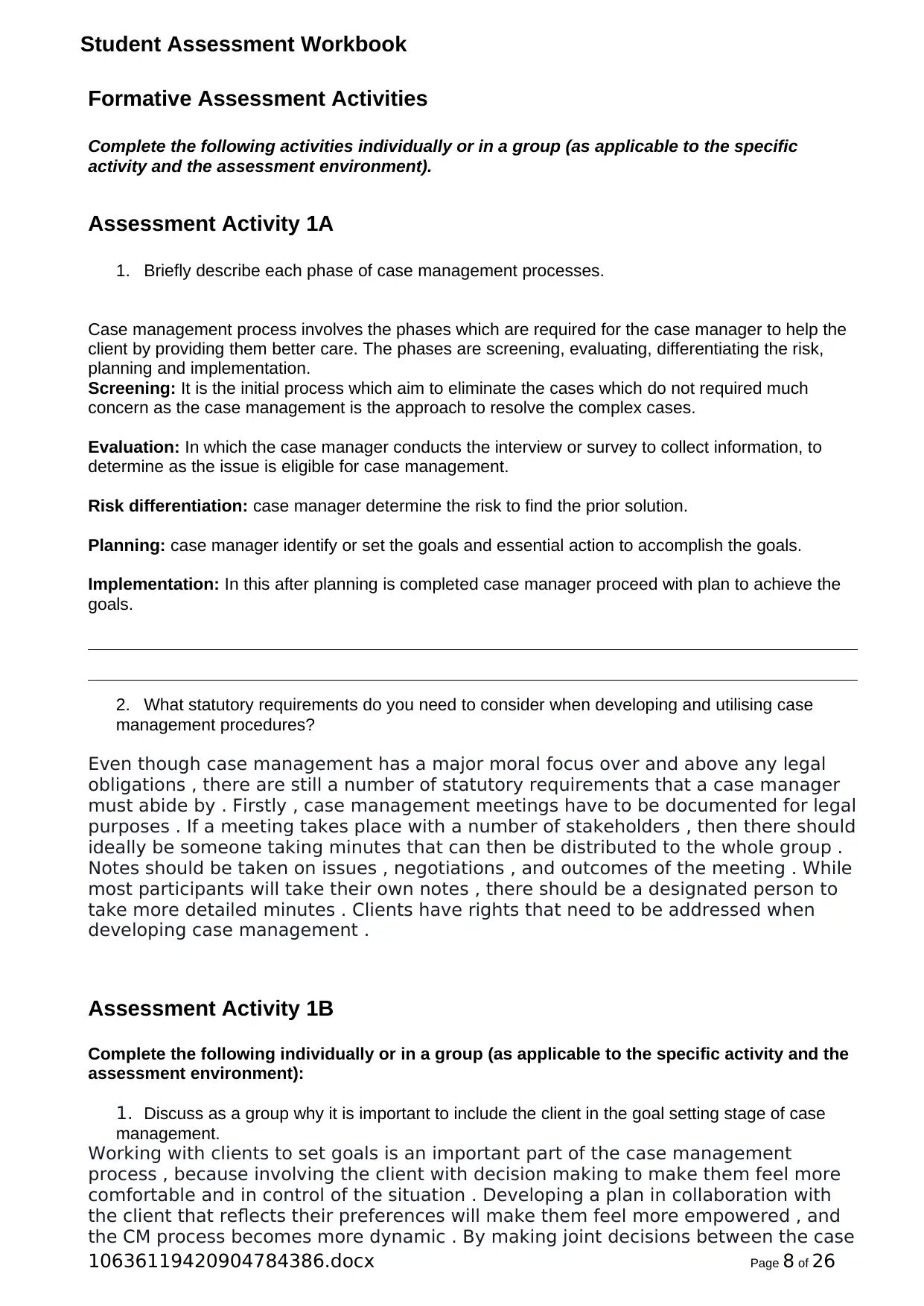
Student Assessment Workbook
Formative Assessment Activities
Complete the following activities individually or in a group (as applicable to the specific
activity and the assessment environment).
Assessment Activity 1A
1. Briefly describe each phase of case management processes.
Case management process involves the phases which are required for the case manager to help the
client by providing them better care. The phases are screening, evaluating, differentiating the risk,
planning and implementation.
Screening: It is the initial process which aim to eliminate the cases which do not required much
concern as the case management is the approach to resolve the complex cases.
Evaluation: In which the case manager conducts the interview or survey to collect information, to
determine as the issue is eligible for case management.
Risk differentiation: case manager determine the risk to find the prior solution.
Planning: case manager identify or set the goals and essential action to accomplish the goals.
Implementation: In this after planning is completed case manager proceed with plan to achieve the
goals.
2. What statutory requirements do you need to consider when developing and utilising case
management procedures?
Even though case management has a major moral focus over and above any legal
obligations , there are still a number of statutory requirements that a case manager
must abide by . Firstly , case management meetings have to be documented for legal
purposes . If a meeting takes place with a number of stakeholders , then there should
ideally be someone taking minutes that can then be distributed to the whole group .
Notes should be taken on issues , negotiations , and outcomes of the meeting . While
most participants will take their own notes , there should be a designated person to
take more detailed minutes . Clients have rights that need to be addressed when
developing case management .
Assessment Activity 1B
Complete the following individually or in a group (as applicable to the specific activity and the
assessment environment):
1. Discuss as a group why it is important to include the client in the goal setting stage of case
management.
Working with clients to set goals is an important part of the case management
process , because involving the client with decision making to make them feel more
comfortable and in control of the situation . Developing a plan in collaboration with
the client that reflects their preferences will make them feel more empowered , and
the CM process becomes more dynamic . By making joint decisions between the case
10636119420904784386.docx Page 8 of 26
Formative Assessment Activities
Complete the following activities individually or in a group (as applicable to the specific
activity and the assessment environment).
Assessment Activity 1A
1. Briefly describe each phase of case management processes.
Case management process involves the phases which are required for the case manager to help the
client by providing them better care. The phases are screening, evaluating, differentiating the risk,
planning and implementation.
Screening: It is the initial process which aim to eliminate the cases which do not required much
concern as the case management is the approach to resolve the complex cases.
Evaluation: In which the case manager conducts the interview or survey to collect information, to
determine as the issue is eligible for case management.
Risk differentiation: case manager determine the risk to find the prior solution.
Planning: case manager identify or set the goals and essential action to accomplish the goals.
Implementation: In this after planning is completed case manager proceed with plan to achieve the
goals.
2. What statutory requirements do you need to consider when developing and utilising case
management procedures?
Even though case management has a major moral focus over and above any legal
obligations , there are still a number of statutory requirements that a case manager
must abide by . Firstly , case management meetings have to be documented for legal
purposes . If a meeting takes place with a number of stakeholders , then there should
ideally be someone taking minutes that can then be distributed to the whole group .
Notes should be taken on issues , negotiations , and outcomes of the meeting . While
most participants will take their own notes , there should be a designated person to
take more detailed minutes . Clients have rights that need to be addressed when
developing case management .
Assessment Activity 1B
Complete the following individually or in a group (as applicable to the specific activity and the
assessment environment):
1. Discuss as a group why it is important to include the client in the goal setting stage of case
management.
Working with clients to set goals is an important part of the case management
process , because involving the client with decision making to make them feel more
comfortable and in control of the situation . Developing a plan in collaboration with
the client that reflects their preferences will make them feel more empowered , and
the CM process becomes more dynamic . By making joint decisions between the case
10636119420904784386.docx Page 8 of 26
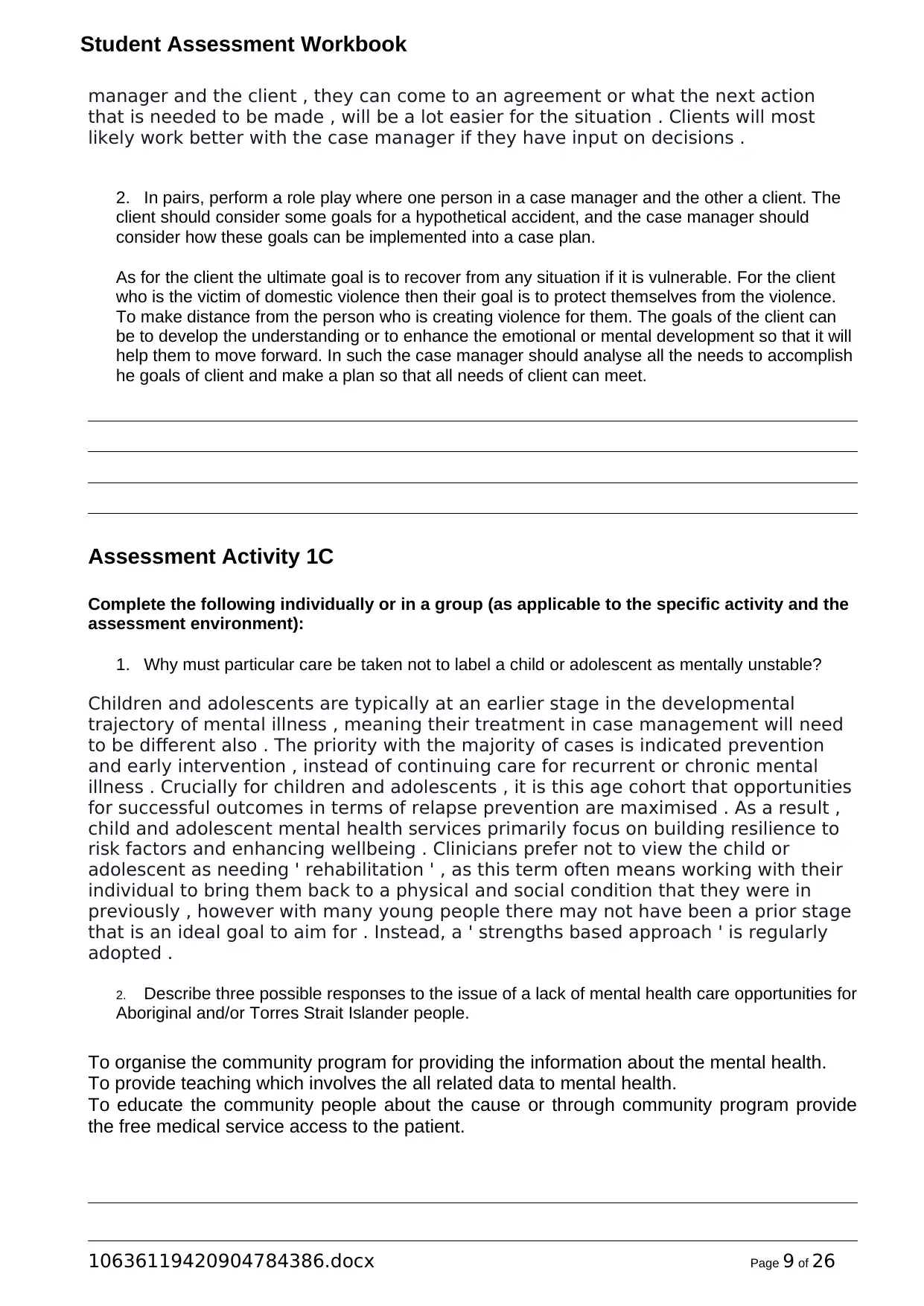
Student Assessment Workbook
manager and the client , they can come to an agreement or what the next action
that is needed to be made , will be a lot easier for the situation . Clients will most
likely work better with the case manager if they have input on decisions .
2. In pairs, perform a role play where one person in a case manager and the other a client. The
client should consider some goals for a hypothetical accident, and the case manager should
consider how these goals can be implemented into a case plan.
As for the client the ultimate goal is to recover from any situation if it is vulnerable. For the client
who is the victim of domestic violence then their goal is to protect themselves from the violence.
To make distance from the person who is creating violence for them. The goals of the client can
be to develop the understanding or to enhance the emotional or mental development so that it will
help them to move forward. In such the case manager should analyse all the needs to accomplish
he goals of client and make a plan so that all needs of client can meet.
Assessment Activity 1C
Complete the following individually or in a group (as applicable to the specific activity and the
assessment environment):
1. Why must particular care be taken not to label a child or adolescent as mentally unstable?
Children and adolescents are typically at an earlier stage in the developmental
trajectory of mental illness , meaning their treatment in case management will need
to be different also . The priority with the majority of cases is indicated prevention
and early intervention , instead of continuing care for recurrent or chronic mental
illness . Crucially for children and adolescents , it is this age cohort that opportunities
for successful outcomes in terms of relapse prevention are maximised . As a result ,
child and adolescent mental health services primarily focus on building resilience to
risk factors and enhancing wellbeing . Clinicians prefer not to view the child or
adolescent as needing ' rehabilitation ' , as this term often means working with their
individual to bring them back to a physical and social condition that they were in
previously , however with many young people there may not have been a prior stage
that is an ideal goal to aim for . Instead, a ' strengths based approach ' is regularly
adopted .
2. Describe three possible responses to the issue of a lack of mental health care opportunities for
Aboriginal and/or Torres Strait Islander people.
To organise the community program for providing the information about the mental health.
To provide teaching which involves the all related data to mental health.
To educate the community people about the cause or through community program provide
the free medical service access to the patient.
10636119420904784386.docx Page 9 of 26
manager and the client , they can come to an agreement or what the next action
that is needed to be made , will be a lot easier for the situation . Clients will most
likely work better with the case manager if they have input on decisions .
2. In pairs, perform a role play where one person in a case manager and the other a client. The
client should consider some goals for a hypothetical accident, and the case manager should
consider how these goals can be implemented into a case plan.
As for the client the ultimate goal is to recover from any situation if it is vulnerable. For the client
who is the victim of domestic violence then their goal is to protect themselves from the violence.
To make distance from the person who is creating violence for them. The goals of the client can
be to develop the understanding or to enhance the emotional or mental development so that it will
help them to move forward. In such the case manager should analyse all the needs to accomplish
he goals of client and make a plan so that all needs of client can meet.
Assessment Activity 1C
Complete the following individually or in a group (as applicable to the specific activity and the
assessment environment):
1. Why must particular care be taken not to label a child or adolescent as mentally unstable?
Children and adolescents are typically at an earlier stage in the developmental
trajectory of mental illness , meaning their treatment in case management will need
to be different also . The priority with the majority of cases is indicated prevention
and early intervention , instead of continuing care for recurrent or chronic mental
illness . Crucially for children and adolescents , it is this age cohort that opportunities
for successful outcomes in terms of relapse prevention are maximised . As a result ,
child and adolescent mental health services primarily focus on building resilience to
risk factors and enhancing wellbeing . Clinicians prefer not to view the child or
adolescent as needing ' rehabilitation ' , as this term often means working with their
individual to bring them back to a physical and social condition that they were in
previously , however with many young people there may not have been a prior stage
that is an ideal goal to aim for . Instead, a ' strengths based approach ' is regularly
adopted .
2. Describe three possible responses to the issue of a lack of mental health care opportunities for
Aboriginal and/or Torres Strait Islander people.
To organise the community program for providing the information about the mental health.
To provide teaching which involves the all related data to mental health.
To educate the community people about the cause or through community program provide
the free medical service access to the patient.
10636119420904784386.docx Page 9 of 26
⊘ This is a preview!⊘
Do you want full access?
Subscribe today to unlock all pages.

Trusted by 1+ million students worldwide
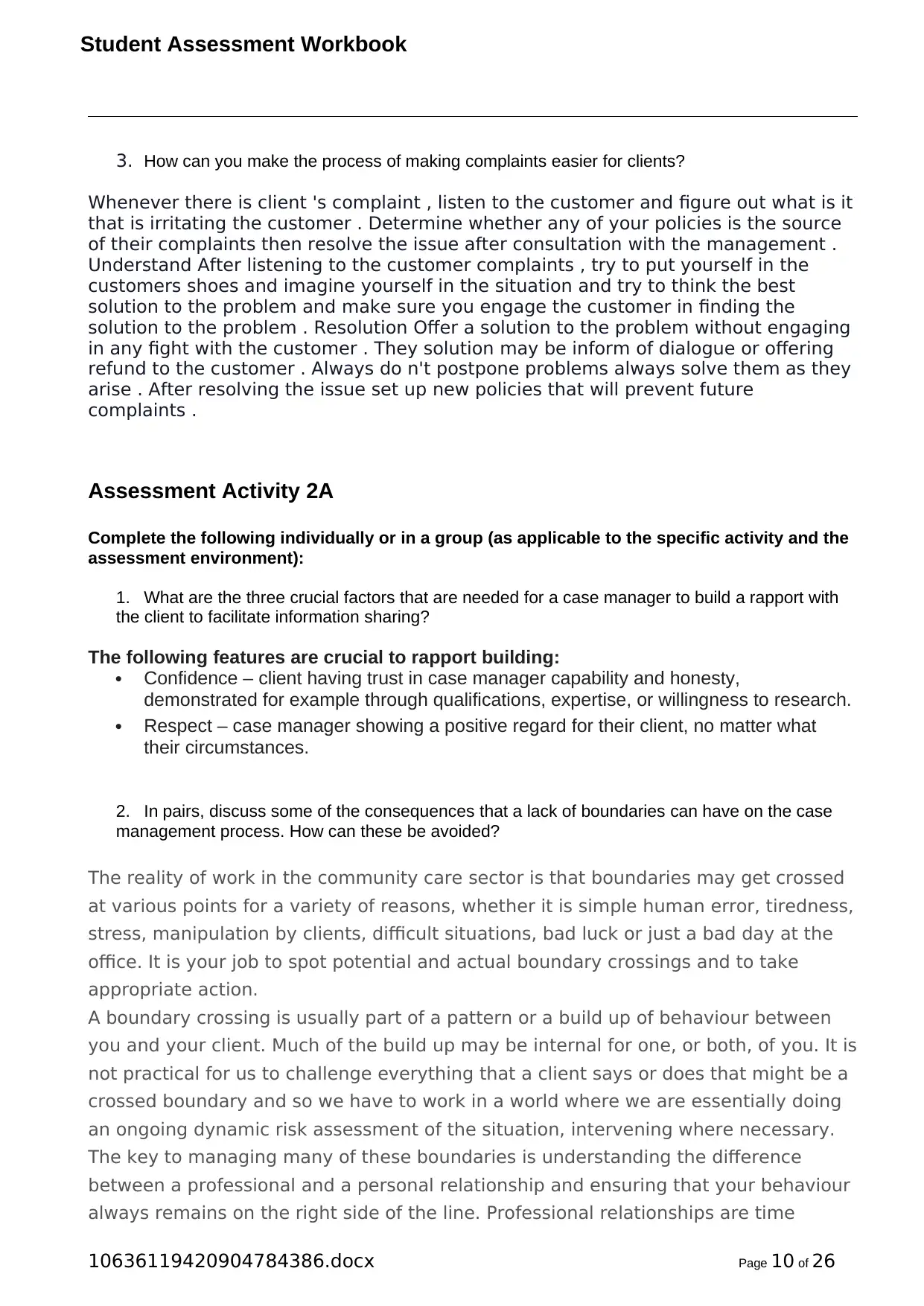
Student Assessment Workbook
3. How can you make the process of making complaints easier for clients?
Whenever there is client 's complaint , listen to the customer and figure out what is it
that is irritating the customer . Determine whether any of your policies is the source
of their complaints then resolve the issue after consultation with the management .
Understand After listening to the customer complaints , try to put yourself in the
customers shoes and imagine yourself in the situation and try to think the best
solution to the problem and make sure you engage the customer in finding the
solution to the problem . Resolution Offer a solution to the problem without engaging
in any fight with the customer . They solution may be inform of dialogue or offering
refund to the customer . Always do n't postpone problems always solve them as they
arise . After resolving the issue set up new policies that will prevent future
complaints .
Assessment Activity 2A
Complete the following individually or in a group (as applicable to the specific activity and the
assessment environment):
1. What are the three crucial factors that are needed for a case manager to build a rapport with
the client to facilitate information sharing?
The following features are crucial to rapport building:
Confidence – client having trust in case manager capability and honesty,
demonstrated for example through qualifications, expertise, or willingness to research.
Respect – case manager showing a positive regard for their client, no matter what
their circumstances.
2. In pairs, discuss some of the consequences that a lack of boundaries can have on the case
management process. How can these be avoided?
The reality of work in the community care sector is that boundaries may get crossed
at various points for a variety of reasons, whether it is simple human error, tiredness,
stress, manipulation by clients, difficult situations, bad luck or just a bad day at the
office. It is your job to spot potential and actual boundary crossings and to take
appropriate action.
A boundary crossing is usually part of a pattern or a build up of behaviour between
you and your client. Much of the build up may be internal for one, or both, of you. It is
not practical for us to challenge everything that a client says or does that might be a
crossed boundary and so we have to work in a world where we are essentially doing
an ongoing dynamic risk assessment of the situation, intervening where necessary.
The key to managing many of these boundaries is understanding the difference
between a professional and a personal relationship and ensuring that your behaviour
always remains on the right side of the line. Professional relationships are time
10636119420904784386.docx Page 10 of 26
3. How can you make the process of making complaints easier for clients?
Whenever there is client 's complaint , listen to the customer and figure out what is it
that is irritating the customer . Determine whether any of your policies is the source
of their complaints then resolve the issue after consultation with the management .
Understand After listening to the customer complaints , try to put yourself in the
customers shoes and imagine yourself in the situation and try to think the best
solution to the problem and make sure you engage the customer in finding the
solution to the problem . Resolution Offer a solution to the problem without engaging
in any fight with the customer . They solution may be inform of dialogue or offering
refund to the customer . Always do n't postpone problems always solve them as they
arise . After resolving the issue set up new policies that will prevent future
complaints .
Assessment Activity 2A
Complete the following individually or in a group (as applicable to the specific activity and the
assessment environment):
1. What are the three crucial factors that are needed for a case manager to build a rapport with
the client to facilitate information sharing?
The following features are crucial to rapport building:
Confidence – client having trust in case manager capability and honesty,
demonstrated for example through qualifications, expertise, or willingness to research.
Respect – case manager showing a positive regard for their client, no matter what
their circumstances.
2. In pairs, discuss some of the consequences that a lack of boundaries can have on the case
management process. How can these be avoided?
The reality of work in the community care sector is that boundaries may get crossed
at various points for a variety of reasons, whether it is simple human error, tiredness,
stress, manipulation by clients, difficult situations, bad luck or just a bad day at the
office. It is your job to spot potential and actual boundary crossings and to take
appropriate action.
A boundary crossing is usually part of a pattern or a build up of behaviour between
you and your client. Much of the build up may be internal for one, or both, of you. It is
not practical for us to challenge everything that a client says or does that might be a
crossed boundary and so we have to work in a world where we are essentially doing
an ongoing dynamic risk assessment of the situation, intervening where necessary.
The key to managing many of these boundaries is understanding the difference
between a professional and a personal relationship and ensuring that your behaviour
always remains on the right side of the line. Professional relationships are time
10636119420904784386.docx Page 10 of 26
Paraphrase This Document
Need a fresh take? Get an instant paraphrase of this document with our AI Paraphraser
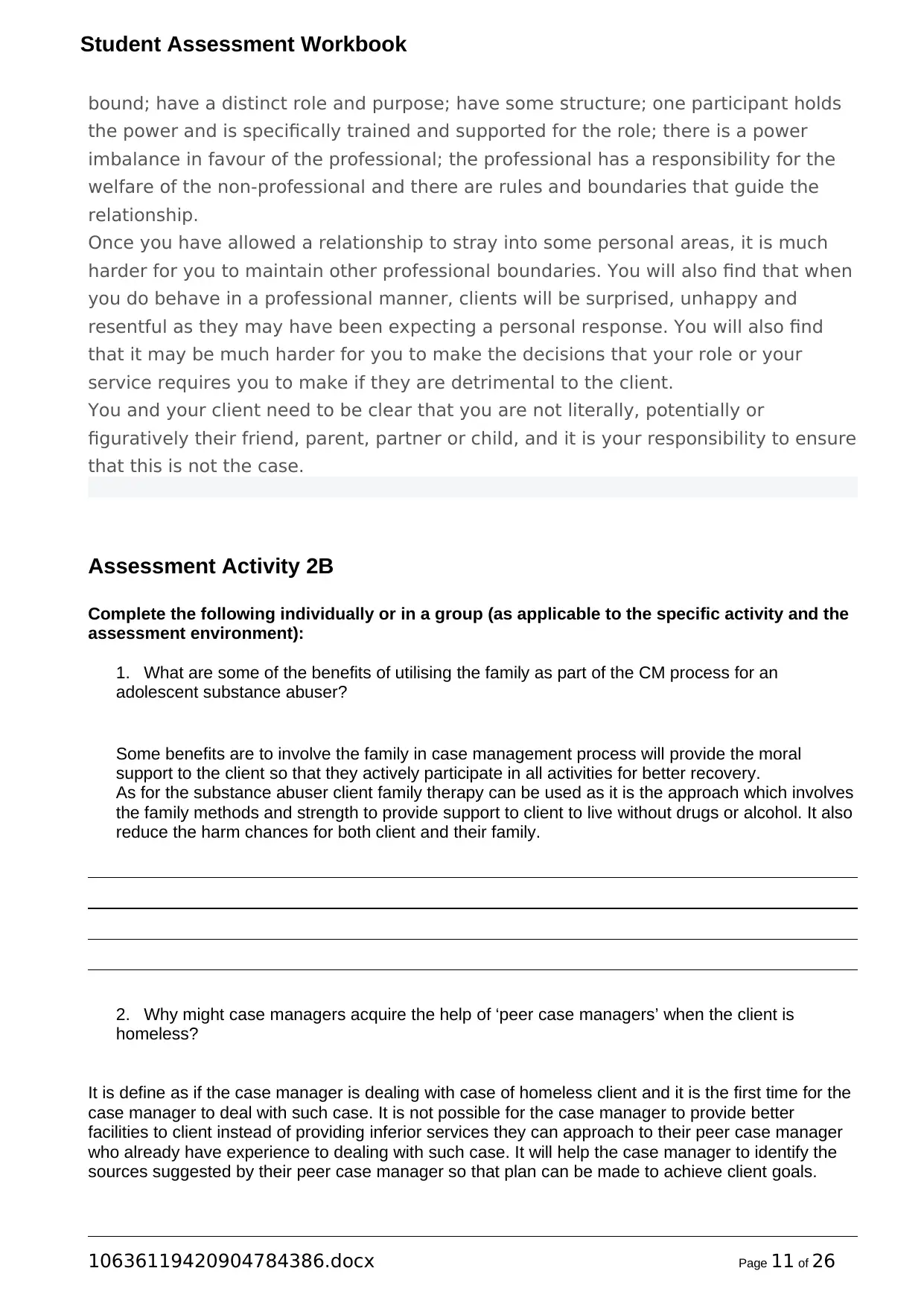
Student Assessment Workbook
bound; have a distinct role and purpose; have some structure; one participant holds
the power and is specifically trained and supported for the role; there is a power
imbalance in favour of the professional; the professional has a responsibility for the
welfare of the non-professional and there are rules and boundaries that guide the
relationship.
Once you have allowed a relationship to stray into some personal areas, it is much
harder for you to maintain other professional boundaries. You will also find that when
you do behave in a professional manner, clients will be surprised, unhappy and
resentful as they may have been expecting a personal response. You will also find
that it may be much harder for you to make the decisions that your role or your
service requires you to make if they are detrimental to the client.
You and your client need to be clear that you are not literally, potentially or
figuratively their friend, parent, partner or child, and it is your responsibility to ensure
that this is not the case.
Assessment Activity 2B
Complete the following individually or in a group (as applicable to the specific activity and the
assessment environment):
1. What are some of the benefits of utilising the family as part of the CM process for an
adolescent substance abuser?
Some benefits are to involve the family in case management process will provide the moral
support to the client so that they actively participate in all activities for better recovery.
As for the substance abuser client family therapy can be used as it is the approach which involves
the family methods and strength to provide support to client to live without drugs or alcohol. It also
reduce the harm chances for both client and their family.
2. Why might case managers acquire the help of ‘peer case managers’ when the client is
homeless?
It is define as if the case manager is dealing with case of homeless client and it is the first time for the
case manager to deal with such case. It is not possible for the case manager to provide better
facilities to client instead of providing inferior services they can approach to their peer case manager
who already have experience to dealing with such case. It will help the case manager to identify the
sources suggested by their peer case manager so that plan can be made to achieve client goals.
10636119420904784386.docx Page 11 of 26
bound; have a distinct role and purpose; have some structure; one participant holds
the power and is specifically trained and supported for the role; there is a power
imbalance in favour of the professional; the professional has a responsibility for the
welfare of the non-professional and there are rules and boundaries that guide the
relationship.
Once you have allowed a relationship to stray into some personal areas, it is much
harder for you to maintain other professional boundaries. You will also find that when
you do behave in a professional manner, clients will be surprised, unhappy and
resentful as they may have been expecting a personal response. You will also find
that it may be much harder for you to make the decisions that your role or your
service requires you to make if they are detrimental to the client.
You and your client need to be clear that you are not literally, potentially or
figuratively their friend, parent, partner or child, and it is your responsibility to ensure
that this is not the case.
Assessment Activity 2B
Complete the following individually or in a group (as applicable to the specific activity and the
assessment environment):
1. What are some of the benefits of utilising the family as part of the CM process for an
adolescent substance abuser?
Some benefits are to involve the family in case management process will provide the moral
support to the client so that they actively participate in all activities for better recovery.
As for the substance abuser client family therapy can be used as it is the approach which involves
the family methods and strength to provide support to client to live without drugs or alcohol. It also
reduce the harm chances for both client and their family.
2. Why might case managers acquire the help of ‘peer case managers’ when the client is
homeless?
It is define as if the case manager is dealing with case of homeless client and it is the first time for the
case manager to deal with such case. It is not possible for the case manager to provide better
facilities to client instead of providing inferior services they can approach to their peer case manager
who already have experience to dealing with such case. It will help the case manager to identify the
sources suggested by their peer case manager so that plan can be made to achieve client goals.
10636119420904784386.docx Page 11 of 26

Student Assessment Workbook
Assessment Activity 3A
Complete the following individually or in a group (as applicable to the specific activity and the
assessment environment):
In pairs, perform a role play where one person is the client and the other a case manager. Think of a
hypothetical situation for the CM process being needed, and discuss the strengths, abilities, and goals
of the client.
For instance if the client is victim of the domestic violence then it is required for the case manager to
provide all the precautional so that client can overcome from the mental trauma which they have
experienced during their violence days. The strength for the client can be seen as if the client is easily
recovering and not facing too much problem then it is their strength to grab or implement the things
rapidly. Abilities as to easily understanding the medical services goals can be to develop the
emotional and mental state so that they can easily forgot the fast and to move forward to achieve the
career goals.
Assessment Activity 3B
Complete the following individually or in a group (as applicable to the specific activity and the
assessment environment):
1. In a group discuss the requirements for a case manager when formulating a case
management plan.
For preparing the case management plan the requirement can be to first meet with the client to
identify their needs and requirement, to clarify their goals or objectives. Then it will guide the case
manager to set the priorities accordingly, if they are facing any problem then they can take the
support of their senior to make the plan for the client. It will assist the case manager to select the
better health care service provider, and help them to negotiate with the price for the treatment.
10636119420904784386.docx Page 12 of 26
Assessment Activity 3A
Complete the following individually or in a group (as applicable to the specific activity and the
assessment environment):
In pairs, perform a role play where one person is the client and the other a case manager. Think of a
hypothetical situation for the CM process being needed, and discuss the strengths, abilities, and goals
of the client.
For instance if the client is victim of the domestic violence then it is required for the case manager to
provide all the precautional so that client can overcome from the mental trauma which they have
experienced during their violence days. The strength for the client can be seen as if the client is easily
recovering and not facing too much problem then it is their strength to grab or implement the things
rapidly. Abilities as to easily understanding the medical services goals can be to develop the
emotional and mental state so that they can easily forgot the fast and to move forward to achieve the
career goals.
Assessment Activity 3B
Complete the following individually or in a group (as applicable to the specific activity and the
assessment environment):
1. In a group discuss the requirements for a case manager when formulating a case
management plan.
For preparing the case management plan the requirement can be to first meet with the client to
identify their needs and requirement, to clarify their goals or objectives. Then it will guide the case
manager to set the priorities accordingly, if they are facing any problem then they can take the
support of their senior to make the plan for the client. It will assist the case manager to select the
better health care service provider, and help them to negotiate with the price for the treatment.
10636119420904784386.docx Page 12 of 26
⊘ This is a preview!⊘
Do you want full access?
Subscribe today to unlock all pages.

Trusted by 1+ million students worldwide
1 out of 26
Related Documents
Your All-in-One AI-Powered Toolkit for Academic Success.
+13062052269
info@desklib.com
Available 24*7 on WhatsApp / Email
![[object Object]](/_next/static/media/star-bottom.7253800d.svg)
Unlock your academic potential
Copyright © 2020–2025 A2Z Services. All Rights Reserved. Developed and managed by ZUCOL.





